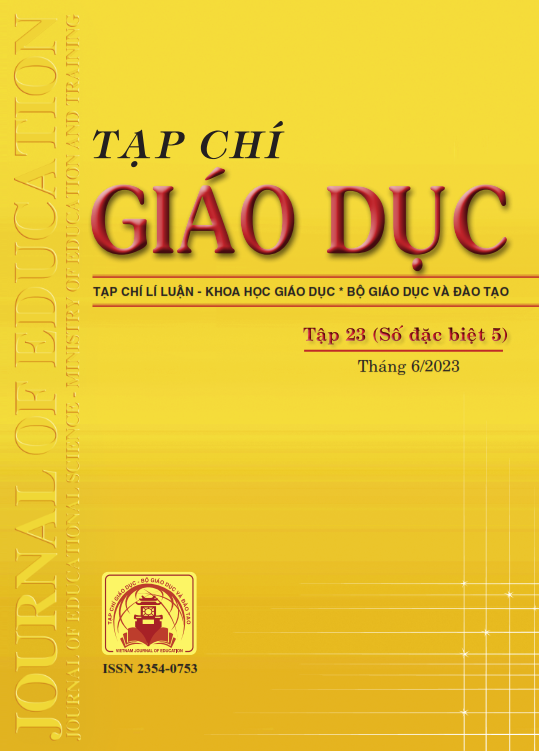Mô hình thiết kế ngược và phương pháp dạy học dựa trên vấn đề trong đào tạo sinh viên sư phạm
Tóm tắt
Backward Design and Problem-Based Learning are not too new concepts in education, but practical applications have proven their effectiveness. In this paper, through some theoretical foundations and a review of studies related to the two methods mentioned above published in educational journals in many countries over the past decade, we propose a model that integrates two teaching approaches, problem-based learning (PBL) and backward design, into a curriculum that prepares teachers for training pedagogical students. We recognize that it will be a challenge to prepare pedagogical students to design lessons with a “student-centered” approach. Applying the new model in the context of Vietnamese education will be difficult at first, but this is an important step towards innovating the way of teaching in order to improve and sustainably develop the education system in Vietnam.
Tài liệu tham khảo
Bidabadi, N. S., Isfahani, A. N., Rouhollahi, A., & Khalili, R. (2016). Effective teaching methods in higher education: Requirements and barriers. Journal of Advances in Medical Education & Professionalism, 4(4), 170-178.
Bowen, R. S. (2017). Understanding by design. Vanderbilt University Center for Teaching. Retrieved April 10, 2023. https://cft.vanderbilt.edu/understanding-by-design/
Bộ GD-ĐT (2018). Chương trình giáo dục phổ thông môn Toán (ban hành kèm theo Thông tư số 32/2018/TT-BGDĐT ngày 26/12/2018 của Bộ trưởng Bộ GD-ĐT).
Cui, Z., Ng, O., & Jong, M. S.-Y. (2023). Integration of computational thinking with mathematical problem-based learning: Insights on affordances for learning. Educational Technology & Society, 26(2), 131-146. https://doi.org/10.30191/ETS.202304_26(2).0010
Dole, S., Bloom, L., & Kowalske, K. (2016). Transforming pedagogy: Changing perspectives from teacher-centered to learner-centered. Interdisciplinary Journal of Problem-Based Learning, 10(1). https://doi.org/10.7771/1541-5015.1538
Harrington, Bowen, J. A., & Zakrajsek, T. (2017). Dynamic lecturing: Research-based strategies to enhance lecture effectiveness (T. Zakrajsek, Ed.). Stylus Publishing LLC.
Jozwik, S., Lin, M., & Cuenca-Carlino, Y. (2017). Using backward design to develop service-learning projects in teacher preparation. New Waves (Rockville, Md.), 20(2), 35-49.
Lally, V., Knutton, S., Windale, M., & Henderson, J. (1992). A collaborative teacher-centred model of in-service education. Educational Review (Birmingham), 44(2), 111-126. https://doi.org/10.1080/0013191920440201
Lathan, J. (n.d.). Complete guide to teacher-centered vs. student-centered learning. University of San Diego. https://onlinedegrees.sandiego.edu/teacher-centered-vs-student-centered-learning/
Nguyễn Ngọc Ánh, Nguyễn Kiều Lan Thương (2018). Giáo dục Việt Nam: Thực trạng, cơ hội và thách thức. Tạp chí Giáo dục lí luận, 279, 54-60.
Rosen, L. D. (2017). The distracted student mind - enhancing its focus and attention. Phi Delta Kappan, 99(2), 8-14. https://doi.org/10.1177/0031721717734183
Sawant, S. P. & Rizvi, S. (2015). Study of passive didactic teacher centered approach and an active student centered approach in teaching anatomy. International Journal of Anatomy and Research, 3(3), 1192-1197. http://dx.doi.org/10.16965/ijar.2015.147
Shadoian-Gersing, V. (n.d.). Education in Vietnam. Retrieved April 10, 2023, from https://asiasociety.org/global-cities-education-network/education-vietnam
Strollo, & Davis, K. L. (2017). Incorporating problem-based learning (PBL) into the chemistry curriculum: Two practitioners’ experiences. In Liberal Arts Strategies for the Chemistry Classroom. American Chemical Society (pp. 133-151). https://doi.org/10.1021/bk-2017-1266.ch008
Ünver, G. (2014). Connecting theory and practice in teacher education: A case study. Educational Sciences: Theory & Practice. https://doi.org/10.12738/estp.2014.4.2161
Vidal, T. C., Dos Santos, S. C., & Carvalho, R. S. (2016). PBL-tutor canvas: A tool based on backward design to plan PBL in computing education. 2016 IEEE Frontiers in Education Conference (FIE). https://doi.org/10.1109/fie.2016.7757386
Wiggins, G. P., & McTighe, J. (1998). Understanding by design (pp. 13–34). Association for Supervision and Curriculum Development (ASCD).
Yew, E. H. J., & Goh, K. (2016). Problem-based learning: An overview of its process and impact on learning. Health Professions Education, 2(2), 75-79. https://doi.org/10.1016/j.hpe.2016.01.004
Zhang, S., Zimmerman, A., Prather-Jones, B., Linda, G., Hutchison, L., Byrd, M., Nguyen, G.-N., Yeigh, M. Rigney, J., McGrail, E., & Darden, A. (2023). The history of the ATE distinguished research in teacher education award: Learning from the past and looking ahead [Symposium]. Association of Teacher Educators Annual Conference. Jacksonville, FL.
Đã Xuất bản
Cách trích dẫn
Số
Chuyên mục
Giấy phép

Tác phẩm này được cấp phép theo Ghi nhận tác giả của Creative Commons Giấy phép quốc tế 4.0 .












